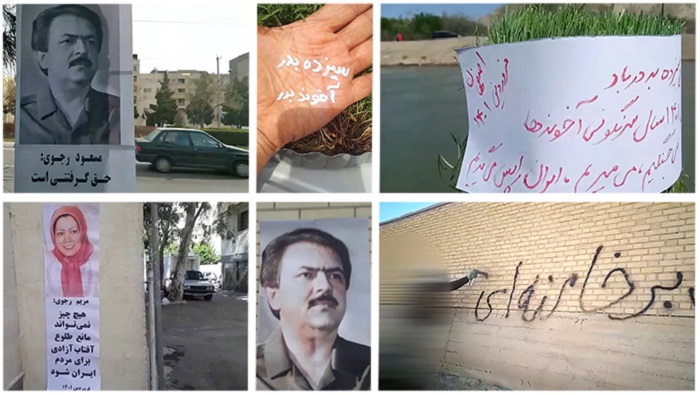
On the 13th day of the Persian year, Iranians typically go to the countryside and find a green area next to a river or a lake. “Sizdah Be Dar” is the name of this tradition. On this day, people tie grasses together, wishing to rid themselves of all the poor fortune from the previous year and wishing the best for the coming year.
Supporters of Iran’s opposition People’s Mojahedin of Iran (PMOI/MEK) and members of the country’s growing network of Resistance Units celebrated the tradition in the hopes of overthrowing the regime by the end of the year and establishing a democratic government following the fall of Supreme Leader Ali Khamenei and the mullahs’ regime in its entirety.
The Resistance Units wrote under a large photo of Resistance Leader Massoud Rajavi that they posted in Tehran, “we will rise and reclaim our legitimate rights.” Similar demonstrations were held in Tehran and other cities.
Several Resistance Units marched along the riverbank, sending audio and video messages to the Iranian people. In Tehran, a member of the Resistance Unit said, “This year will be the year of the regime’s overthrow.”
Members of the Resistance Units celebrated the new year and century in defiance of the mullahs’ suppression by reiterating their commitment to overthrow the mullahs’ regime and establish freedom in Iran at the start of the year.
The Iranian Resistance Units marked the new year by putting up photos of Iranian Resistance leaders in cities and writing slogans calling for the regime’s overthrow on walls. Large images of Iranian Resistance leader Massoud Rajavi and Mrs. Maryam Rajavi, President-elect of the Iranian opposition coalition National Council of Resistance of Iran (NCRI), were projected on the Resalat Highway, which runs from east to west through the city, on March 29.
March 29 – Tehran, #Iran
9:00 pm local time
Large images of Iranian Resistance leader Massoud Rajavi, and Mrs. Maryam Rajavi, President-elect of the Iranian opposition coalition NCRI, displayed near a major highway.#FreeIran2022pic.twitter.com/xrVrghgCoQ— People's Mojahedin Organization of Iran (PMOI/MEK) (@Mojahedineng) March 30, 2022
Massoud Rajavi, the leader of the Iranian Resistance, based his strategy on the establishment of Resistance Units within Iran, with the goal of forming a bond between the revolution’s files and the ranks seen in the movement’s central core, the PMOI/MEK.
Despite the fact that the “resistance units” strategy was devised years ago, as crises in Iran worsen and the regime’s internal schisms widen, as well as several rounds of uprising from 2018 to the present, the “resistance units” strategy has had a widespread impact.
The MEK’s anti-crackdown campaign, which began on January 27 with the disruption of numerous state TV and radio networks and continued with Resistance Units seizing control of loudspeakers to blast anti-regime slogans in public, is clearly linked. And the trend is continuing right now.
March 19 – Mashhad, northeast #Iran
Anti-regime slogans aired in public
"Death to Khamenei!"
"Hail to Rajavi!"
Excerpts of speeches delivered by Iranian Resistance leader Massoud Rajavi & NCRI President-elect @Maryam_Rajavi#IranProtests #اعتراضات_سراسریpic.twitter.com/FSomReKVLI— People's Mojahedin Organization of Iran (PMOI/MEK) (@Mojahedineng) March 19, 2022
It is obvious that the regime has numerous internal schisms among its ranks and ranks. On February 9, the Intelligence Ministry displayed a blindfolded man claiming responsibility for the broadcasting of anti-regime slogans in Mashhad’s famous Bazaar Reza. Despite a propaganda campaign aimed at instilling fear in the Iranian people, the Iranian people and their organized resistance continue to take these steps.
The mullahs’ regime has not been able to plunge the Iranian nation into poverty and hopelessness, despite resorting to an increasing number of executions and oppressive measures in tandem with unbearable economic pressures.
Every episode of anti-regime slogans broadcast in public places across the country serves as a reminder to the regime of the Iranian people’s unwavering refusal to submit to the regime’s crackdown. When such measures have been in place for months, it’s only natural to assume that the vast majority of Iran’s society is behind them.
MEK Iran (follow us on Twitter and Facebook), Maryam Rajavi’s on her site, Twitter & Facebook, NCRI (Twitter & Facebook), and People’s Mojahedin Organization of Iran – MEK IRAN – YouTu








